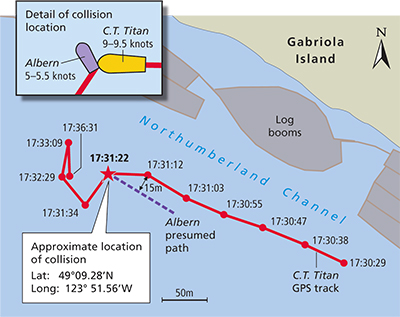Two tugboats heading for home after a day in the log booms collided in the Northumberland Channel last year off Vancouver Island, British Columbia. Canadian investigators said the master aboard one tug left the controls unattended before impact.
The collision occurred just after 1730 on May 24, 2016, as the tugs C.T. Titan and Albern sailed toward Nanaimo, B.C. According to a recent Transportation Safety Board of Canada (TSB) report, C.T. Titan’s captain left the flying bridge for the wheelhouse seconds before the vessel swung abruptly to port and hit the smaller tug, causing it to sink.
Albern rolled over and capsized on impact, and its two mariners were briefly trapped underwater before swimming to safety. Minor pollution from fuel and oil on board the sunken tug was reported.
TSB investigators learned C.T. Titan’s rudders were misaligned, and they believe this caused the tug to turn sharply. But the agency also cited the captain’s decision to leave the controls unattended as another factor in the incident.
“The investigation determined that it was the vessel’s tendency to veer to port or to starboard when the steering controls were unattended, as well as the rudders’ misalignment to port, that likely led to the C.T. Titan veering to port,” the report said.
“When the C.T. Titan veered to port, its proximity to the Albern meant that the master had only two to four seconds to respond to the situation and could not successfully complete the process of transferring propulsion control in such a short time,” the report continued.
Jones Marine Group of Chemainus, B.C., operated both vessels. The company did not respond to requests for comment on the incident.
The 365-hp Albern had two people on board, while the 940-hp C.T. Titan had a captain and two deck hands. The tugs spent the day of the incident working in log booming grounds around Gabriola, B.C., and were heading back toward Nanaimo Harbor for a crew change.
 |
|
Courtesy TSB/Pat Rossi illustration |
Albern left the log grounds about a minute before C.T. Titan, whose master began the voyage from the flying bridge. With C.T. Titan roughly 50 feet behind the smaller tug, its master left for the wheelhouse after making sure the two vessels were on a parallel track.
The flying bridge propulsion controls were at full ahead and the rudders were roughly amidships when the captain left the flying bridge. He reached the wheelhouse six to eight seconds later but could not transfer the controls to that station in time to prevent the accident.
C.T. Titan hit Albern’s starboard quarter two to four seconds after the captain reached the wheelhouse, the report said. The twin-screw tug rode up onto Albern’s capsized hull before coming under control.
“Albern capsized and trapped its two crewmembers underwater,” the report said, adding that the deck hand escaped the flooded wheelhouse through a door, while the master escaped through a shattered window. Both were rescued by C.T. Titan.
Multiple masters on C.T. Titan regularly moved between control stations while underway, the TSB said. During this maneuver, the master can take control at the new station by placing propulsion levers in neutral and pressing a button. From that point, the operator has four seconds to align the levers at the new station with those at the last station.
“Because this informal practice was performed repeatedly over the years without any risk assessment and without adverse consequences, the masters perceived the hazards associated with the practice as low, or acceptable,” the report said.
During the investigation, authorities learned C.T. Titan’s port outer and starboard inner rudders were out of alignment toward the port side, each by about 3 degrees. After the tug was repaired, the TSB attempted to replicate the scenario that preceded the collision. The propulsion control transfer system functioned normally, but the vessel did not hold a straight line.
Investigators determined downflooding through Albern’s open forecastle hatch caused it to sink. The tug went down in more than 300 feet of water and was not salvaged. C.T. Titan underwent repairs to its keel cooler and other components and re-entered service three months after the accident.

